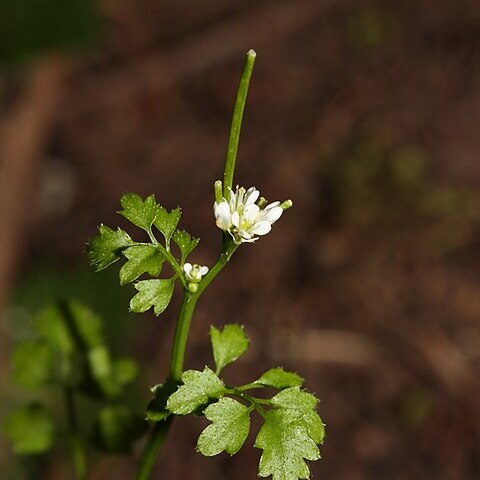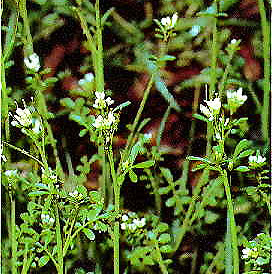Herbs annual, biennial, or rhizomatous or tuberous perennial. Trichomes absent or simple. Stems erect or prostrate, leafy or rarely leafless and plant scapose. Basal leaves petiolate, rosulate or not, simple and entire, toothed, or 1-3-pinnatisect, or palmately lobed, sometimes trifoliolate, pinnately, palmately, or bipinnately compound. Cauline leaves alternate, (rarely opposite or whorled), simple or compound as basal leaves, petiolate or sessile and base cuneate, attenuate, auriculate, or sagittate, margin entire, dentate, or variously lobed. Racemes ebracteate or rarely bracteate throughout or only basally, corymbose or in panicles, elongated in fruit. Fruiting pedicels slender or thickened, erect, divaricate, or reflexed. Sepals ovate or oblong, base of lateral pair saccate or not, margin often membranous. Petals white, pink, purple, or violet, never yellow, rarely absent; blade obovate, spatulate, oblong, or oblanceolate, apex obtuse or emarginate; claw absent or strongly differentiated from blade, longer or shorter than sepals. Stamens 6 and tetradynamous, rarely 4 and equal in length; anthers ovate, oblong, or linear, obtuse at apex. Nectar glands confluent and subtending bases of all stamens; median glands 2 or rarely 4 or absent; lateral glands annular or semiannular. Ovules 4-50 per ovary. Fruit dehiscent siliques, linear or rarely narrowly oblong or narrowly lanceolate, latiseptate, sessile; valves papery, not veined, glabrous (or very rarely hairy), smooth or torulose, dehiscing elastically acropetally, spirally or circinately coiled; replum strongly flattened; septum complete, membranous, translucent; style distinct or rarely obsolete; stigma capitate, entire. Seeds uniseriate, wingless, rarely margined or winged, oblong or ovate, flattened; seed coat smooth, minutely reticulate, colliculate, or rugose; mucilaginous or not when wetted; cotyledons accumbent or very rarely incumbent.
Annual, biennial or perennial, small to large herbs, with a taproot and often with creeping or tuberous rhizomes. Hairs often present, simple. Stems erect, ascending, sometimes basally rooting. Racemes mostly terminal, ebracteate, densely to laxly corymbose, with a few to numerous small to medium-sized flowers, in fruit at least basally elongate and lax. Sepals not saccate, not spreading; margins hyaline. Petals white, cream, violet or purple, spathulate to clawed, sometimes lacking. Stamens 6-4, rarely fewer; filaments linear to subulate. Nectaries horseshoe-shaped or a close ring-shaped tissue around the lateral stamen and usually as a conical gland outside each median pair of stamens. Ovary cylindrical, usually with a short narrower style; stigma flat; ovules 4-40. Fruit a siliqua, dehiscent, linear, straight, tapered towards the narrow style; stigma flat; fruit disrupting explosively by the valves coiling from the base upwards; replum swollen; valves without prominent nerves. Seeds uniseriate, flattened, usually broadly elliptic to oblong, minutely rugose to colliculate, not mucilaginous.
Annual, biennial or perennial small to large herbs, with a taproot and often with creeping or tuberous rhizomes. Hairs often present, unicellular, simple. Stems erect, ascending, sometimes basally rooting. Racemes mostly terminal, ebracteate, densely to laxly corymbose, with a few-numerous small to medium-sized flowers, in fruit at least basally elongate and lax. Sepals not saccate, not spreading, margins hyaline. Petals white, cream, violet or purple, spathulate to clawed, sometimes lacking. Stamens 6–4, rarely fewer; filaments linear to subulate. Nectaries horseshoe-shaped or a closed ring-shaped tissue around the lateral stamens and usually as a conical gland outside each median pair of stamens. Ovary cylindrical, usually with a short narrower style; stigma flat; ovules 4–40. Fruit a siliqua, dehiscent, linear, straight, tapered towards the narrow style, disrupting explosively by the valves coiling from the base upwards; replum swollen; valves without prominent nerves. Seeds uniseriate, flattened, usually broadly elliptic to oblong, minutely rugose to colliculate, not mucilaginous.
Annual to perennial rhizomatous or taprooted herbs. Hairs simple or 0. Stems ascending to erect, sparsely leafy. Lvs simple and entire to pinnatifid or pinnate; lobes entire or bluntly to sharply lobed or toothed. Racemes ebracteate, sometimes contracted to a loose umbel or corymb, sometimes whole infl. sessile. Sepals erecto-patent, the inner slightly saccate. Petals white, rarely pink or mauve, or 0. Stamens (4)-6. Lateral nectaries 2, in a circle or semicircle around single stamens; median nectaries 2, variously shaped, outside paired stamens. Style long or short; stigma capitate or 2-lobed. Silique linear, dehiscent; valves veinless or with a weak median vein, flat, coiling suddenly and tightly from base at dehiscence, glabrous or hairy; beak 0. Seeds ellipsoid, not or barely winged, in 1 row per locule.
Sep erect, obtuse; pet white to pink or purple, or rarely none; stamens in some spp. fewer than 6; short stamens subtended by a semicircular gland; anthers oblong; ovary cylindric, gradually tapering to the short, slender style; stigma truncate or nearly so; fr linear, terete or quadrangular, straight, many-seeded, tipped with the persistent style, which in the Dentaria group commonly forms an evident, slender beak 6–8 mm; persistent frame of the replum relatively broad or slightly wing-margined; seeds in a single row in each locule, flattened, wingless; annual to perennial herbs with simple to pinnately or palmately compound or trifid (even biternate) lvs; pubescence none or of simple hairs. 200, cosmop. (Dentaria)
Annual or perennial herbs. Leaves variable in dissection and size, usually less than 10 cm long. Inflorescence usually many-flowered racemes. Sepals equal or nearly so. Petals clawed, white or pink. Stamens 4 or 6. Nectariferous glands in half-ring around shorter stamens and variously shaped outside longer, median stamens. Stigma entire or slightly bilobed. Siliqua dehiscent, the valves released suddenly from the base upwards, ejecting the seeds; valves flat, without conspicuous veins; replum margin flanged. Seeds in 1 row per locule. Radicle accumbent.
Perennial or less frequently annual herbs, pubescent with simple trichomes or glabrous; stems leafy, the leaves petiolate and usually pinnately compound; in-florescence racemose, ebracteate or the lower flowers bracteate; petals spatulate to obovate, white to pink; siliques linear, compressed parallel to the replum, dehiscent by linear, often elastic, valves, tapering at apex to a cylindrical style; stigma usually 2-lobed; seeds emarginate or rarely very narrowly winged.
Sepals erect with spreading tips; petals clawed. Stamens 6, or rarely fewer; stigmas simple or 2-lobed, subsessile; siliques linear, straight; ovules us. ∞, in one series, flattened; cots accumbent. Annual or perennial herbs, glab. or pubescent; lvs simple to compound. About 120 spp., mainly of temperate regions. C. subcarnosa is reported from Macquarie Id; C. corymbosa occurs there and is reported from Fuegia. The other N.Z. spp. are endemic.
Silique laterally compressed, often opening explosively, the valves coiling spirally from the base.
Flowers white or purple in terminal, subumbellate racemes.
Seeds 1-seriate, smooth or finely tuberculate.
Leaves simple, trifoliolate or pinnate.
Inner sepals not or scarcely saccate.
Petals 4, occasionally absent.
Annual or perennial herbs.
Cotyledons accumbent.
Stamens 6 (4).


